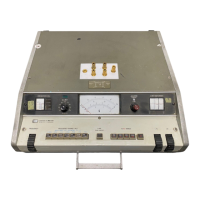Section V
Paragraphs 5-37 to 5-44
Model 4342A
5-37.
TROUBLESHOOTING GUIDES.
5-38.
This paragraph and those below provide
information helpful to isolating a faulty
circuit in a defective unit and the appro-
priate remedy for the trouble. Component
level troubleshooting procedures are provided
in Figures 5-13 and 5-14 in the form of flow
diagrams [however, for simple circuits com-
posed of only a few (active) components,
these figures treat the breakdown only to
circuit block level and component level
troubleshooting procedure is omitted]. Before
proceeding with troubleshooting, verify
whether any external factor relating to the
instrument operating environment is contri-
buting to the trouble symptoms.
The follow-
ing paragraphs outline some considerations
for such external troubles:
5-39. High Frequency Line Noise.
High frequency noise superposed on the AC
power line may possibily cause an abnormal
deflection of the Q meter regardless of the
sample measured. If meter pointer shows al-
most the sane deflection on any FREQUENCY and
Q RANGE setting, check quality of operating
power line. To isolate trouble, proceed as
follows:
1) Operate the instrument from another ac
power line and attempt measurement.
2) Securely ground the instrument chassis
to earth.
If the symnton disappears or is different,
use the sane procedures on actual neasure-
ments or use a line filter in the power line.
5-40. Operating in a Strong Electromagnetic
Field.
When the instrument is operated in a strong
RF electromagnetic field, two (or more) re-
sonant frequency points are sometimes ob-
served on the Q meter indication. This
symptom arises from the fact that the Q-
measuring circuit resonates with the oscil-
lator signal injected into the circuit and
additionally with the RF signal induced by
the electromagnetic field as well.
In prac-
tice,
this trouble sometimes occurs when the
instrument is located near a high power
transmitting station (such as a broadcasting
station).
The meter "true" tuning deflection
can be easily distinguished from the "false"
behavior because the amplitude of any meter
deflection caused by such external electro-
magnetic field is irrespective of the Q range.
One solution to this trouble is to enclose
the instrument in a grounded wire net shield.
Securely ground the instrument.
5-41. Operation in High Humidity
Environment.
The Q factor of a high Q inductor is generally
sensitive to atmospheric humidity. Usually,
ordinary high Q inductors tend to show a pro-
nounced decrease in Q factor when they are
located in a high humidity environment (more
than 80%). If Q meter indicates a lower Q
value (different from a nominal value of the
sample), compare instrument reading by using
a Q reference coil or a stable inductor (her-
metically sealed).
5-42. ELEMENTARY TROUBLESHOOTING GUIDE.
5-43. Meter Zeroing Troubles.
If Q meter does not indicate zero after the
instrument is turned on and if meter zero
adjustment (Figure 3-6) is not successful,
A6 DC Amplifier Assembly is probably faulty.
Check differential meter amplifier (A6Q2, 43,
44 and QS) and dc power supply voltages on
the circuit board.
5-44.
Incorrect Q Meter Indication.
If indicated Q values of Q measurements are
incorrect (compared with a known sample),
the trouble is probably located in either
the oscillator section or the Q voltmeter
section. (If no deflection at all can be
obtained, first check power supply voltages).
To isolate the trouble, proceed as follows:
a.
Connect a RF Voltmeter to 4342A LO
and GND terminals.
b. Set 4342A Q RANGE to 30.
C.
Rotate FREQUENCY dial from lowest to
highest frequency on each FREQUENCY
RANGE setting and check RF voltmeter
reading.
d.
RF Voltmeter reading should be within
30nV *O.SmVrns at any frequency set-
ting. If this check fails, trouble-
shoot oscillator section and follow
Figure 5-12 Troubleshooting Tree. If
OK, troubleshoot voltmeter section and
follow Figure 5-13 Troubleshooting
Tree.
5-18

